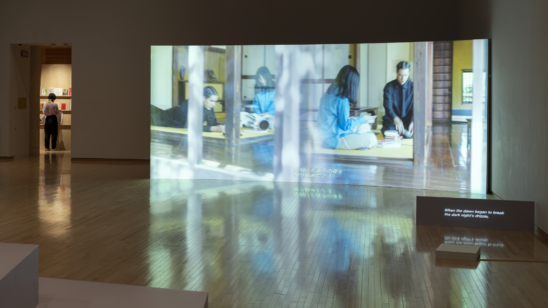Weaving a story in harmony
Zuiun-an, a 100-year-old two-story wooden house and storehouse, will host an exhibition featuring three artists who are influenced by and think about Japanese culture and sensibility through different forms of expression such as painting, sculpture, and video installation. The “harmony” created by their works and the unique space of a Japanese house will allow visitors to imagine “a story” for themselves. The exhibition also aims to provide an opportunity for reconsidering the aesthetic sense, values, and cultural perspectives unique to Japan through the “harmony” of sharing the stories imagined by the participating artists, curators, and other viewers.
<Exhibition Statement>
Thank you for following the pathway to view the exhibition, “Weaving a story in harmony”, by Soshi Nakamura, Daijiro Hama, and Shota Matsui. We hope that each of you will freely imagine the stories created by the mixture of the unique space of the Japanese house and the artworks.
We also encourage you to share your own imagined stories and impressions with others present here, as “sharing” is one of the elements of “wa”, the title of this exhibition.
As the curator of this exhibition, I would like to share a story that came to me when I first saw the exhibition. If you would like to share yours, please do so later. My story will change with the new perspectives that emerge from it.
–
My grandfather had a shed in his yard where he enjoyed painting and making dolls and figurines out of paper and clay. Helping my grandfather to make things and coloring them was my playtime. There were many tools in the shed, but they were so neatly organized and carefully used that each one had a specific place to be stored. Whenever I didn’t put things away or treated them roughly, he would say to me angrily, “You will be punished if you do that! There are all kinds of gods everywhere!” Even in my childish mind at the time, I still get a kick out of those words and take them seriously.
We often went for leisure walks together, observing various things along the way. One by one, he would find something interesting and stop, seemingly conversing with the plants, trees, and insects as well. He threw and kicked stones, but also picked up and brought back those that radiated a mysterious beauty. I wondered how these stones came to be. I looked up at the sky and wondered if they had fallen to earth from the far reaches of the universe. My eyes were drawn to the ever-changing clouds, and the breeze made me feel good, as if I, too, could float and be swept away.
The mountains in the distance from the country road with its open vista looked huge, but as I went closer and climbed up, I saw trees, flowers, insects, and animals, and they were the mountains. A water source in the mountains, was gushing out of the ground. The flow and sound of it somehow refreshed my mind.
The way my grandfather shared with me how to be close to nature taught me that each tiny particle of energy makes a magnificent world, and that the flow of energy is constantly changing and circulating.
The first time I faced death was when my beloved grandfather passed away. I was sad and lonely, of course, but for some reason, I was able to accept it immediately. I still feel that my grandfather is watching over me even after his death. It is not so much a spiritual presence, but rather a sense that he is part of what my grandfather taught me — that we live in harmony with nature and are watched over by nature.
Watanabe Kentaro (Curator)
- Held by
- 108 artworks
- Supported by
- Nishieda Foundation、Art Collaboration Kyoto Executive Committee
- Venue
- Zuiun-an
- Website
- Weaving a story in harmony
Photo by : Masaki Tada




